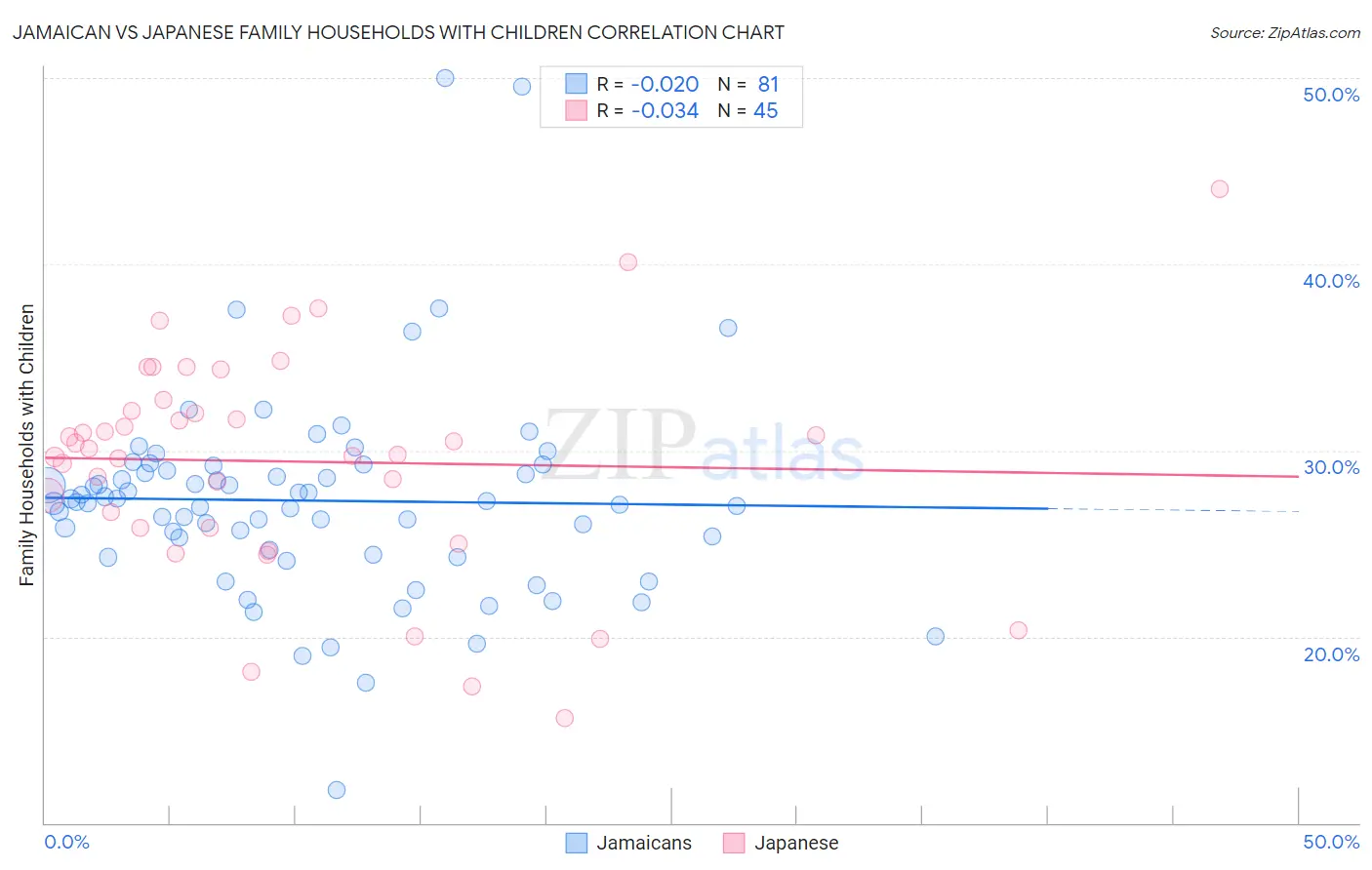Jamaican vs Japanese Family Households with Children
COMPARE
Jamaican
Japanese
Family Households with Children
Family Households with Children Comparison
Jamaicans
Japanese
26.9%
FAMILY HOUSEHOLDS WITH CHILDREN
2.5/ 100
METRIC RATING
246th/ 347
METRIC RANK
29.4%
FAMILY HOUSEHOLDS WITH CHILDREN
100.0/ 100
METRIC RATING
31st/ 347
METRIC RANK
Jamaican vs Japanese Family Households with Children Correlation Chart
The statistical analysis conducted on geographies consisting of 367,528,470 people shows no correlation between the proportion of Jamaicans and percentage of family households with children in the United States with a correlation coefficient (R) of -0.020 and weighted average of 26.9%. Similarly, the statistical analysis conducted on geographies consisting of 249,052,059 people shows no correlation between the proportion of Japanese and percentage of family households with children in the United States with a correlation coefficient (R) of -0.034 and weighted average of 29.4%, a difference of 9.5%.

Family Households with Children Correlation Summary
| Measurement | Jamaican | Japanese |
| Minimum | 11.8% | 15.6% |
| Maximum | 50.0% | 44.0% |
| Range | 38.2% | 28.4% |
| Mean | 27.3% | 29.4% |
| Median | 27.2% | 30.1% |
| Interquartile 25% (IQ1) | 24.5% | 25.8% |
| Interquartile 75% (IQ3) | 29.1% | 32.4% |
| Interquartile Range (IQR) | 4.5% | 6.6% |
| Standard Deviation (Sample) | 5.5% | 5.9% |
| Standard Deviation (Population) | 5.5% | 5.9% |
Similar Demographics by Family Households with Children
Demographics Similar to Jamaicans by Family Households with Children
In terms of family households with children, the demographic groups most similar to Jamaicans are Potawatomi (26.9%, a difference of 0.060%), Australian (26.9%, a difference of 0.070%), Immigrants from Kazakhstan (26.9%, a difference of 0.070%), Ukrainian (26.9%, a difference of 0.090%), and Immigrants from Eastern Europe (26.9%, a difference of 0.090%).
| Demographics | Rating | Rank | Family Households with Children |
| Immigrants | Southern Europe | 3.4 /100 | #239 | Tragic 26.9% |
| Immigrants | Bulgaria | 3.3 /100 | #240 | Tragic 26.9% |
| Navajo | 3.2 /100 | #241 | Tragic 26.9% |
| Immigrants | England | 3.2 /100 | #242 | Tragic 26.9% |
| Immigrants | Saudi Arabia | 2.9 /100 | #243 | Tragic 26.9% |
| Ukrainians | 2.9 /100 | #244 | Tragic 26.9% |
| Australians | 2.8 /100 | #245 | Tragic 26.9% |
| Jamaicans | 2.5 /100 | #246 | Tragic 26.9% |
| Potawatomi | 2.2 /100 | #247 | Tragic 26.9% |
| Immigrants | Kazakhstan | 2.2 /100 | #248 | Tragic 26.9% |
| Immigrants | Eastern Europe | 2.1 /100 | #249 | Tragic 26.9% |
| Belgians | 2.1 /100 | #250 | Tragic 26.9% |
| Immigrants | Bosnia and Herzegovina | 1.9 /100 | #251 | Tragic 26.8% |
| Irish | 1.8 /100 | #252 | Tragic 26.8% |
| Italians | 1.5 /100 | #253 | Tragic 26.8% |
Demographics Similar to Japanese by Family Households with Children
In terms of family households with children, the demographic groups most similar to Japanese are Immigrants from Yemen (29.4%, a difference of 0.060%), Yuman (29.5%, a difference of 0.14%), Samoan (29.5%, a difference of 0.18%), Bolivian (29.5%, a difference of 0.18%), and Venezuelan (29.4%, a difference of 0.26%).
| Demographics | Rating | Rank | Family Households with Children |
| Guamanians/Chamorros | 100.0 /100 | #24 | Exceptional 29.7% |
| Immigrants | Latin America | 100.0 /100 | #25 | Exceptional 29.7% |
| Sri Lankans | 100.0 /100 | #26 | Exceptional 29.5% |
| Immigrants | Vietnam | 100.0 /100 | #27 | Exceptional 29.5% |
| Samoans | 100.0 /100 | #28 | Exceptional 29.5% |
| Bolivians | 100.0 /100 | #29 | Exceptional 29.5% |
| Yuman | 100.0 /100 | #30 | Exceptional 29.5% |
| Japanese | 100.0 /100 | #31 | Exceptional 29.4% |
| Immigrants | Yemen | 100.0 /100 | #32 | Exceptional 29.4% |
| Venezuelans | 100.0 /100 | #33 | Exceptional 29.4% |
| Immigrants | Bolivia | 100.0 /100 | #34 | Exceptional 29.3% |
| Immigrants | Sierra Leone | 100.0 /100 | #35 | Exceptional 29.3% |
| Immigrants | Venezuela | 100.0 /100 | #36 | Exceptional 29.3% |
| Immigrants | Cameroon | 100.0 /100 | #37 | Exceptional 29.2% |
| Koreans | 100.0 /100 | #38 | Exceptional 29.2% |